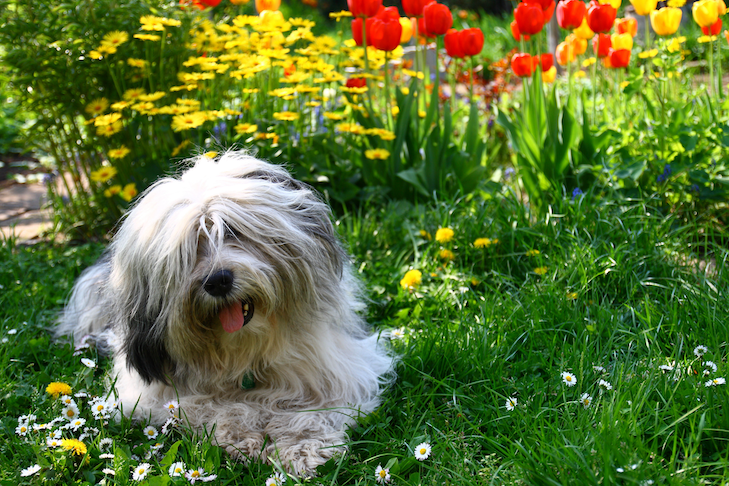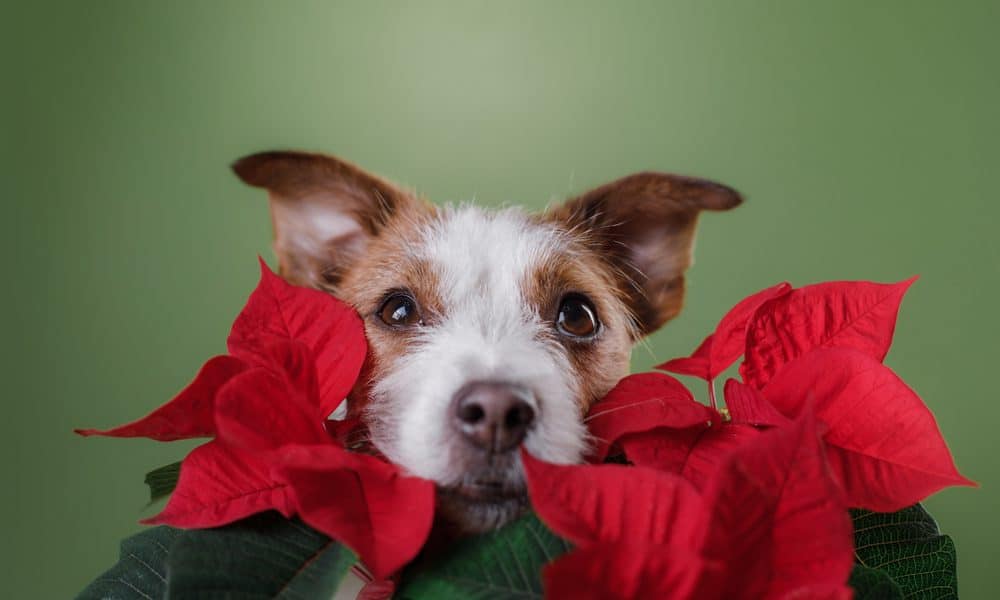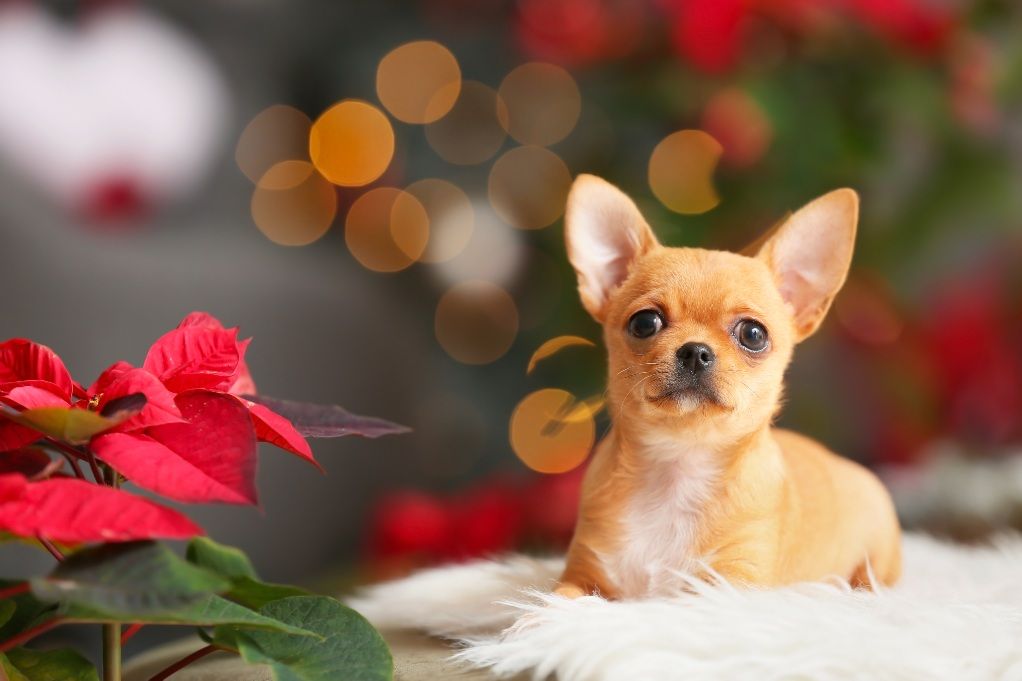The holiday season brings joy and festivity, but amid the merriment, pet owners must be vigilant about potential hazards for their furry friends. Dogs, curious by nature, may inadvertently encounter toxic holiday plants that pose serious health risks. In this article, we'll delve into the perilous world of festive flora and explore how to keep our canine companions safe during the holidays.

As we deck the halls and adorn our homes with festive decorations, it's crucial to recognize the potential dangers that certain plants pose to our happy dogs. While the holidays are a time for celebration, they can also become a time of emergency vet visits if precautions aren't taken.
Poinsettias: Pretty, but Perilous
As the holiday season approaches, homes are adorned with festive decorations, and one iconic plant takes center stage – the poinsettia. These vibrant red leaves are synonymous with Christmas, but did you know they can pose a danger to our canine companions?
Understanding the Threat: Poinsettias contain compounds that, when ingested by dogs, can lead to symptoms such as vomiting and diarrhea. While severe poisoning is rare, it's essential for pet owners to be aware of the potential risks associated with poinsettia exposure in dogs.
Recognizing Symptoms: Learn to identify the signs of poinsettia poisoning in dogs, such as lethargy and loss of appetite. Timely recognition can make all the difference in ensuring your pet's well-being during the holiday festivities.

Mistletoe Mishaps
Mistletoe, often hung as a symbol of love during the holidays, hides a potential threat to our furry friends. However, not all mistletoe is created equal, and understanding the differences can be crucial.
Types of Mistletoe: Explore the various types of mistletoe, from the American to the European varieties. Each has its own level of toxicity, and being informed can help you make safer choices in your holiday decorations.
Symptoms and Complications: Delve into the symptoms of mistletoe poisoning in dogs and the potential complications it can cause. Whether mild or severe, being prepared ensures you can act swiftly if your dog encounters this holiday plant.
Holly: More Than Just Berries
The glossy green leaves and vibrant red berries of holly make it a classic holiday plant. However, the entire holly plant is toxic to dogs, and the dangers extend beyond the berries alone.
Beyond Berries: Understand the full extent of holly toxicity for dogs, including the leaves. This knowledge can guide you in creating a safer environment for your pet while maintaining the festive spirit.
Recognizing Harm: Explore the symptoms associated with holly ingestion in dogs, such as drooling and abdominal pain. Learn how to differentiate between mild reactions and more severe consequences.
Christmas Cactus: Friend or Foe?
Amid the holiday cheer, the Christmas cactus stands out with its vibrant blooms. While this succulent is generally considered safe for dogs, moderation is key to ensuring a festive season free from mishaps.
Safety Assessment: Explore the safety of Christmas cactus for dogs and understand the potential risks associated with its consumption. Knowing the limits can help you enjoy this seasonal plant without compromising your pet's well-being.
Mild Reactions vs. Severe Toxicity: Uncover the potential mild reactions dogs may experience with excessive consumption of Christmas cactus. Additionally, delve into the rare cases of severe toxicity and the associated symptoms that warrant immediate attention.
Amaryllis Alert
Amaryllis, with its stunning blossoms, graces many homes during the holiday season. However, lurking within its beauty are elements that can pose a serious threat to our four-legged companions.
Poisonous Components: Detail the toxic components found in amaryllis bulbs and the potential harm they can cause to dogs. Understanding the specific dangers can guide pet owners in making informed decisions when choosing holiday floral arrangements.
Symptoms and Urgency: Recognize the symptoms of amaryllis poisoning in dogs, ranging from gastrointestinal upset to tremors. Stress the importance of swift action, as timely intervention can significantly impact the outcome for a pet that has ingested this toxic plant.
Cedar and Pine: Beware of the Tree
The enchanting allure of a Christmas tree, bedecked with lights and ornaments, is a hallmark of the holiday season. However, for pet owners, especially those with dogs, it's essential to be mindful of the potential dangers associated with certain trees, such as cedar and pine.
Chewing Hazards: Dogs, known for their inquisitive nature, may find the scent of cedar and pine enticing. Explore the risks associated with dogs chewing on pine needles, which can lead to stomach upset and discomfort. Recognizing these hazards is the first step in creating a safer environment.
Water Additive Concerns: Many households use water additives to prolong the freshness of their Christmas trees. Delve into the potential dangers of these additives, which may contain chemicals that are harmful to pets. Understanding the risks allows pet owners to make informed decisions about tree care.
Pet-Proofing Strategies: Uncover effective strategies for pet-proofing the holiday tree. From securing the tree to choosing pet-safe decorations, proactive measures can help minimize the risks associated with cedar and pine trees in a festive household.
Safe Decorating Practices
Ensuring a pet-safe holiday environment involves more than avoiding toxic plants. General decorating practices can also pose risks to dogs. From tinsel ingestion to electrical cord chewing, it's crucial to implement safety measures.
Consider alternative decorations that pose no threat to dogs, such as pet-friendly ornaments and non-toxic garlands. Supervision is key to preventing potential hazards during the festive season.
Emergency First Aid for Pet Poisoning
Despite precautions, accidents can happen. In the event of a dog ingesting a toxic plant, swift action is crucial. Inducing vomiting may be recommended in some cases, but it's essential to consult with a veterinarian promptly.
Pet owners should keep essential information, such as the type of plant ingested and the dog's weight, on hand when contacting a vet. Immediate action can make a significant difference in the outcome.
Creating Awareness: Share the Knowledge

Prevention is the best medicine, and spreading awareness about toxic holiday plants is paramount. Encourage pet owners to educate their friends and family about potential dangers and share resources for further information.
By collectively raising awareness, we can create a safer environment for our furry friends during the holiday season. Responsible pet ownership involves not only keeping our pets safe but also contributing to the well-being of the broader pet community.
Interview with a Veterinarian
To gain professional insights, we spoke with Dr. Jane Smith, a seasoned veterinarian with extensive experience in treating cases of pet poisoning during the holidays.
"During the festive season, we often see an uptick in cases related to toxic plant ingestion," says Dr. Smith. "Pet owners should be proactive in pet-proofing their homes and seek immediate veterinary attention if they suspect their dog has ingested a toxic plant."
Dr. Smith emphasizes the importance of understanding the specific risks associated with each plant and adopting preventive measures to keep pets safe.
DIY Pet-Safe Decorations
As pet owners, ensuring a festive and safe environment for our furry friends is a top priority during the holiday season. One delightful way to achieve this is by crafting DIY pet-safe decorations that add a personal touch to your celebrations while keeping potential hazards at bay.
Why DIY Pet-Safe Decorations?
Creating your own decorations allows you to control the materials used, ensuring they are safe for your pets. It's a fun and rewarding way to involve the whole family in preparing for the holidays while minimizing risks to your furry companions.
Crafty Ideas for Pet-Safe Decorations
- Felt Ornaments:
- Craft festive ornaments using pet-safe felt. Cut out shapes like bones, paw prints, and pet-themed designs. These ornaments not only look adorable but are also safe if your pet decides to investigate.
- Cardboard Cutouts:
- Transform plain cardboard into holiday-themed cutouts. Whether it's a snowman, a Christmas tree, or a gingerbread person, these lightweight decorations are pet-friendly and easy to create.
- Pet-Safe Garlands:
- String together pet-safe materials like cotton balls, felt shapes, or even pet-friendly treats to create a garland. Hang it in areas where your pet can enjoy the decorations without risk.
- Homemade Stockings:
- Craft personalized stockings for your pets using pet-safe fabrics. Decorate with their names, and fill the stockings with pet-friendly treats and interactive dog toys.
- DIY Pet-Safe Wreaths:
- Create wreaths using materials that are harmless to pets, such as paper or fabric. Add pet-themed embellishments to make them uniquely yours.
Crafting Tips for Pet-Safe Decorations

- Avoid Toxic Glues and Paints:
Opt for non-toxic glue and paint when crafting your decorations. This ensures that even if your pet decides to explore, there's minimal risk of exposure to harmful substances.
- Securely Attach Decorations:
Ensure that any small parts or embellishments are securely attached. This minimizes the risk of your pet ingesting small objects that could be harmful.
- Consider Scented Materials:
Use scents that are pleasing to pets when crafting. For example, incorporating pet-safe herbs like catnip or mint can add a delightful aroma to your decorations.
- Supervise Interaction:
While your DIY decorations are intended to be pet-safe, it's always a good idea to supervise your pets' interaction with them. This allows you to intervene if needed and ensures everyone enjoys the holiday season safely.
Crafting DIY pet-safe decorations not only enhances the festive atmosphere in your home but also creates a space where both you and your pets can celebrate the season without worry.
Testimonials from Pet Owners
In the spirit of shared experiences, we've gathered testimonials from fellow pet owners who have faced challenges related to holiday plants and decorations. These real stories serve as a reminder of the importance of awareness and proactive pet safety during the festive season.
Emily's Cautionary Tale
"Last Christmas, our dog ingested some holly berries, and it turned into a frantic trip to the vet. We had no idea that something as seemingly harmless as holly could be so dangerous. Now, we stick to pet-safe decorations, and we've had worry-free holidays since. It's crucial for everyone to know the potential risks and take steps to protect their pets."
Mark's Vigilance Pays Off
"Our Labrador, Max, has a habit of investigating everything with his mouth. One year, he got a little too curious about the Christmas tree. We didn't realize that the water additive we used could be harmful to pets. Luckily, we caught it early, and Max received prompt veterinary attention. Now, we're extra vigilant about pet-proofing our holiday decorations."
Sarah's Journey to Pet-Friendly Decor
"As a pet owner who loves decorating for the holidays, finding a balance between festive and pet-friendly was important. We started crafting our own pet-safe decorations, like felt ornaments and garlands. Not only do they add a personal touch to our home, but they also give us peace of mind knowing that our cat, Whiskers, can enjoy the decorations safely."
These testimonials emphasize the need for awareness, caution, and creativity when it comes to holiday decorations and plants. As we cherish the joy of the season, let's also prioritize the safety and well-being of our beloved pets.

Conclusion
As we celebrate the holidays, let's prioritize the well-being of our furry companions. By being aware of the toxic holiday plants that pose risks to dogs and implementing preventative measures, we can ensure a safe and joyful season for both humans and their canine friends.
Remember, responsible pet ownership extends beyond the gifts and festivities—keeping our pets safe is the best gift we can give them during the holiday season.
FAQs
- Are all types of mistletoe toxic to dogs?
- While some types of mistletoe are more toxic than others, all varieties can pose a risk to dogs. It's crucial to identify the type of mistletoe in your home and take appropriate precautions.
- Can I have a Christmas tree if I have a dog?
- Yes, you can have a Christmas tree with some precautions. Ensure the tree is securely anchored to prevent it from tipping, and avoid using water additives that may be harmful to pets.
- What should I do if my dog ingests a toxic plant?
- If you suspect your dog has ingested a toxic plant, contact your veterinarian immediately. Provide details such as the type of plant and your dog's weight for prompt and accurate advice.
- Are there any safe holiday plants for dogs?
- Yes, several plants are considered safe for dogs, including Christmas cactus and pet-friendly alternatives like spider plants. Always research before introducing new plants into your home.
- How can I create a pet-friendly holiday atmosphere?
- Opt for pet-safe decorations, secure potentially hazardous items, and provide a designated safe space for your dog during festivities. Engaging in DIY pet-friendly decorations is also a great way to ensure a safe environment.




